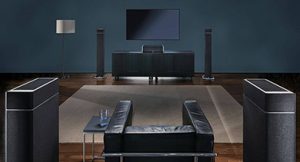An update on Dolby Atmos

Dolby is calling Atmos “the most significant development in cinema audio since surround sound”. We had a wee think about whether we agree with that statement. The answer is: ‘Yeah, I guess so.’
But we’d like to add a side-note and we have said it many times before: While Dolby Atmos provides an awesome experience, we think it’s much better to do 5.1 really well, than to do a 7.1.4 with only half decent products.
Dolby Atmos, may sound like the next marketing tool and really, all you probably care about is that the movie sounds good. We’re big fans of how Dolby Atmos makes you feel like you’re inside the story, with sound coming from all directions, including overhead.
But that in itself wouldn’t necessarily be enough to convert us at this stage. There is a bit more to the whole Dolby Atmos thing that makes it attractive beyond the overhead speakers add-on. Let us explain.
To quickly refresh your memory: Dolby Atmos is an object-based surround sound format. The main eye-catcher for Joe Blogs is probably that it introduced ‘overhead location’ speakers, which basically requires the addition of either in-ceiling speakers or use of special Atmos elevated speakers (basically speakers with additional drivers that direct the sound upward to reflect off your ceiling). We refer to our earlier blog for more info on that.
It’s the object based surround sound idea however that is rather interesting. Object-based surround sound, as opposed to channel-based sound makes each sound in a movie scene—a gunshot or a woman’s scream, for instance—an object. The awesome thing about this is that filmmakers can precisely specify where those sound objects should originate and how they should move, making the experience so much more life-like.
And what’s even smarter is that, unlike channel based sound, it allows for a lot more flexibility. It doesn’t really matter whether you are sitting in a movie theatre with 24 ear-level speakers and 10 overhead speakers or watching on your Amazon Fire Kindle, the blu-ray or streaming video knows how to handle the information for the best possible sound for your situation.
It also doesn’t matter if you have to deal with an oddly shaped room, or whether your speakers are placed in the ‘perfect position’ or not. A Dolby Atmos system will figure out the best way to deal with whatever you throw at it. At least that is the theory.
So, what’s been happening in the Dolby Atmos field since we introduced the technology in our blog a while back?
It was all very much science fiction then, but things have progressed and Dolby Atmos has made it’s way into our home cinema’s.
First and foremost, you need an Atmos compatible AV receiver. These days al major brands are on board with this. Whether it is Yamaha, Pioneer, Onkyo or Anthem, they all have at least several of their amplifiers that are Atmos-enabled. What this means is that the room will receive a calibration which allows sound mixers to ‘place’ sounds and voices at exact points in the room. Each speaker in an Atmos system will have its own feed, enabling new front, surround and ceiling-mounted height channels.
Which brings us to the speakers. As we mentioned before: when you say Atmos, you say overhead speakers. This can be done by installing in-ceiling speakers, although it does not have to be that invasive.
Some speakers are Atmos enabled, which simply means that they have height speakers built in. Examples for this are the Klipsch Reference Premiere Dolby Atmos speakers and the Definitive Technology BP9080 Tower Speakers with integrated subwoofer. Truth be told apart from a few front-runners, availability is still fairly limited.
More available are Atmos enabled speaker modules that can be placed on top of your existing speakers. Definitive Technology, ELAC, SVS, Klipsch all offer options. It’s important to point out that it is not strictly necessary to stick to the same brand as your surround speakers.
Dolby Atmos tech is also available in some high-end soundbars that use up-firing drivers to disperse sound overhead like the Yamaha YSP-5600.
And last but not least, LG has announced that all its 2017 OLED TVs will be the first ever televisions to support Dolby Atmos.
And how about available content?
Since the first release of an Atmos-enabled movie in 2014, many have followed. Peter Jackson and with him a lot of other directors are extatic about the creative possibilities Dolby Atmos offers.
The Dolby Atmos website offers a list of movies that have been released in Dolby Atmos, from Star Trek, to Sully to the Game of Thrones series. The list is growing rapidly.
So is it time to get on board?
While we had our doubts at the start, it looks like Dolby Atmos is taking off fast and is here to stay.
If you are upgrading your system (especially your AV receiver) or planning a renovation, we would recommend planning for the future and at the least pre-wire for overhead speakers.
If money is no objection, by all means, go for the ultimate all-out experience that is Dolby Atmos.
Apart from that, I guess there is no real hurry.